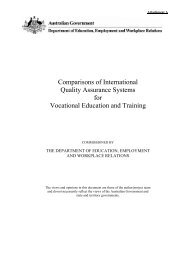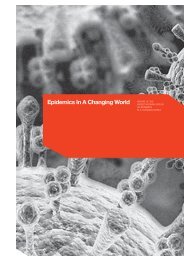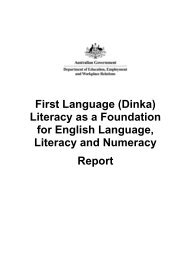2011 Strategic Roadmap for Australian Research Infrastructure
2011 Strategic Roadmap for Australian Research Infrastructure
2011 Strategic Roadmap for Australian Research Infrastructure
You also want an ePaper? Increase the reach of your titles
YUMPU automatically turns print PDFs into web optimized ePapers that Google loves.
Section E: Cross-disciplinary needs<br />
Each of the current National <strong>Research</strong> Priorities identifies research from the<br />
humanities, arts and social sciences as a key goal. However, research<br />
infrastructure to maximise the benefits and reach of the major outputs of the social<br />
and cultural sector is yet to be substantially supported. Appropriately resourced,<br />
the Understanding Cultures and Communities Capability will address this<br />
deficiency. Cross-Capability integration should be sought where possible, to<br />
enable social and cultural research to feed directly into problem-solving within the<br />
domains of science, health, border security, or other priority areas, and more<br />
broadly to enhance investment in and synergies between existing Capabilities 29 .<br />
Several of the facilities created under NCRIS, EIF or Super Science investment<br />
programs <strong>for</strong> scientific research have already demonstrated a capacity to support<br />
projects from multiple disciplines 30 . These projects indicate the potential to extend<br />
data capture and exposure, data processing and analytical services to other<br />
research communities. Examples include the <strong>Australian</strong> Microscopy and<br />
Microanalysis <strong>Research</strong> Facility and other ‘characterisation’ facilities, ANDS and<br />
National e<strong>Research</strong> Collaboration Tools and Resources (NeCTAR), as well as<br />
underpinning data networking provided through the National <strong>Research</strong> Network<br />
(NRN) and the <strong>Australian</strong> <strong>Research</strong> and Education Network (AREN). Existing<br />
Capabilities, such as the Atlas of Living Australia, are also potential models.<br />
5.E.1<br />
What are your views on the cross-disciplinary requirements identified,<br />
including their relative priority and ability to support the current and future<br />
research needs?<br />
Section F: Current developments<br />
In Australia there is a very limited number of humanities, arts and social sciences<br />
projects of a scale which would have a major influence on future research<br />
infrastructure investments. However, Australia is not alone in its need <strong>for</strong> robust<br />
enabling technology solutions to support advanced research in the social and<br />
cultural sector and large-scale investments are being made internationally.<br />
In Europe, <strong>for</strong> example, the European Strategy Forum on <strong>Research</strong> <strong>Infrastructure</strong>s<br />
(ESFRI) has identified a number of projects which aim to provide infrastructure<br />
directly aligned with research needs in the humanities, arts and social sciences<br />
and has prioritised them <strong>for</strong> action. Some projects have been funded and are<br />
being implemented (e.g. the Council of European Social Science Data Archives,<br />
and the European Social Survey Update), while others are funded and are moving<br />
towards implementation (e.g. CLARIN [Common Language Resources and<br />
Technology <strong>Infrastructure</strong>] and DARIAH [Digital <strong>Research</strong> <strong>Infrastructure</strong> <strong>for</strong> the<br />
29<br />
There is a growing number of examples of cross-disciplinary projects designed to address Australia’s large-scale<br />
problems. Two projects focussing on the risks of climate change impacts that emphasise social research are: the Centre <strong>for</strong><br />
Water Sensitive Cities at Monash University (http://www.watersensitivecities.org.au/); and the National Climate Change<br />
Adaptation <strong>Research</strong> Facility, funded by the Department of Climate Change and Energy Efficiency<br />
(http://www.nccarf.edu.au/).<br />
30<br />
<strong>Australian</strong> Urban <strong>Research</strong> <strong>Infrastructure</strong> Network (AURIN) is one example.<br />
50
















